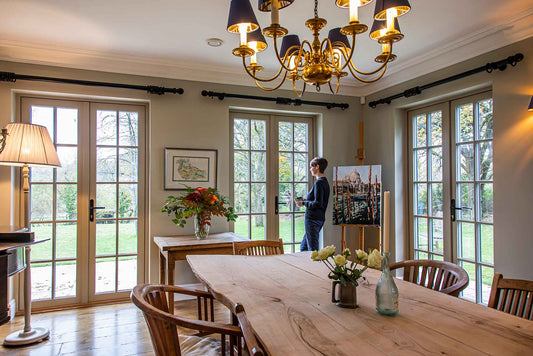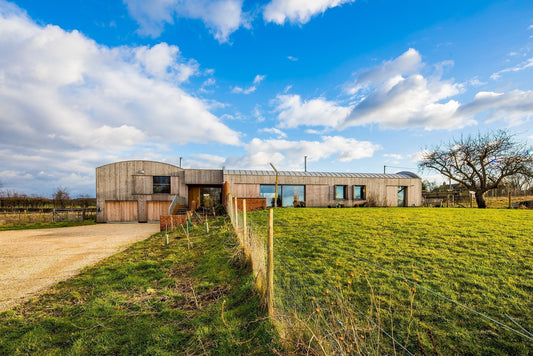The Benefits of Passive Houses
The Passive House concept is taking off. The benefits it offers - both for the environment and for homeowners - are exceptional.
What are they? Should you consider building to Passive Standard? In this article, we highlight the main advantages of Passive House building and why they matter.
What is a Passive House?
The Passive House (or Passivhaus, in Europe) standard is a building standard and construction concept designed to drastically increase the energy efficiency, comfort and longevity of a newly built property.
What are Passive House principles?
Passive Houses achieve their impressively high level of performance by meeting exacting criteria in five main areas of the building's envelope:
- thermal insulation;
- energy efficient triple-glazed windows;
- effective ventilation;
- airtight construction; and
- elimination of thermal bridging and 'cold spots'.
If you're unfamiliar with the criteria covered by the Passive House concept, read a more detailed explanation of the standard here.

Norrsken's P41A windows used in a recently completed Passive House project.
Reduce the energy demand
Heating and cooling makes up around 40% to 60% of energy demand in buildings.
The Passive House standard targets this energy demand specifically - to meet it, buildings must use an annual maximum of 15kWh/m2 for heating or cooling to maintain the building at 20° C.
How does this compare to most buildings? Extremely favourably: it's a reduction in energy consumption of up to 90% compared to the existing building stock, and over 75% even when compared with average new builds.
How is this achieved? Strict performance requirements for the components of a Passive build dramatically reduce the overall energy usage of the property.
For example: efficient mechanical ventilation with heat recovery (MVHR) systems can reduce ventilation heat losses by up to 90%.
Passive-compliant triple-glazed windows can preserve up to 70% more heat than most double-glazing (source: PHI). Even compared to new builds, the step up is pronounced: current building regulations recommend using windows with a U-value of 1.4 W/(m²K); Passive buildings use windows with U-values of 0.80 W/(m²K) or less. A 43% performance improvement.
How does a Passive House benefit its owners?
Energy savings
First and foremost, you can expect meaningful energy savings. Building to the Passive House standard materially reduces the energy usage of a home.
Lower heating costs
Naturally, this equates to a lower cost for heating and cooling your home on an ongoing basis. Lower fuel bills - particularly in today's uncertain and inflationary climate - are no small boon.
Affordability
In the most extreme cases, owners of Passive Houses use just 10% of the energy of their non-Passive equivalents.
The ever-rising cost of fuel makes this calculation a simple one. Over the course of its lifespan, a Passive House will recoup the initial investment into its components and more, making it not only an efficient but affordable building standard.
No performance gap
Rigorous planning and certification processes means that there is usually little to no performance gap. Energy savings predicted from a Passive build are real, not just on-paper figures.
More durable buildings
No cold or damp spots means minimal condensation related damage, and a more durable building.

Passive Houses are often designed to maximise sunlight for heating purposes without overheating the building.
Passive Houses are inherently environmentally friendly

Says the Passipedia website:
"Passive House buildings are eco-friendly by definition: They use extremely little primary energy, leaving sufficient energy resources for all future generations without causing any environmental damage. The additional energy required for their construction [embodied energy] is insignificant compared with the energy they save later on."
48% of emissions from buildings are generated from energy usage in existing homes - predominantly via fossil fuel boilers. 62% of energy usage emissions are produced by heating (UKGBC).
The Passive House concept is a sharp deviation from the traditional, unsustainable, carbon-heavy way we build, heat and run our homes. It represents an approach to building that is inherently geared towards sustainability - and is already making a material difference to the CO2 emissions of new builds and retrofit projects across Europe and the UK.
Renewable energy
A degree of the energy used in Passive Houses is often generated from renewable resources - another feather in the cap of ecological credibility for the standard.
Passive Houses are, as we have noted, very energy efficient. This means that a high proportion of their energy demand can be satisfied by renewable energy sources where, in ordinary, 'inefficient' houses, the effect would be minimal.
Installing photovoltaics in an inefficient house will not significantly mitigate the overall energy demand of the home. Conversely, in a Passive House, where the energy usage is already so low, energy produced by photovoltaics does make an important contribution.
Are Passive Houses healthy?
Passive ventilation systems produce a consistent supply of fresh air throughout the building, meaning higher quality and more hygienic air supply.
UK and European inhabitants now spend the majority of their time indoors - so it's never been more important to ensure the air in our homes is free from pollutants. Passive Houses are designed to ensure that Indoor Air Quality (IAQ) is assured.
Fresh air and a condensation-free environment also reduces the risk of mould, damp and cold spots - healthier for the inhabitants, and comfortable.
Passive buildings are designed, not just to be energy efficient, but with the comfort of their owners at the forefront. Passive House designer Elrond Burrell writes in more depth about this advantage of Passive Houses here.
Why will Passive Houses be the future?
Global attention has never been more sharply focused on the climate. With energy prices rising and entire ecosystems at risk across the globe, the construction industry cannot afford to be energy inefficient.
The Passive Standard has just celebrated its 30th year of existence, but its long-sighted and sustainable approach to building is more pertinent than ever.
The rigorous environmental, comfort and quality standards imposed by a Passive House ensure real, long-term benefits for homeowners and the environment.
Norrsken & Passive Houses
Many of our customers are attracted by the very real improvement in comfort, living conditions and energy consumption that Passive House requirements bring - so we're accustomed to supplying and installing for customers building to Passive - or near Passive - standards.
You can browse our range of triple-glazed windows - a selection of which are suitable for Passive builds, here.
Are triple-glazed windows right for you?
Triple-glazing provides homeowners a marked increase – 40-45% - in thermal performance from double-glazed alternatives, meaning greater comfort, lower heating bills, and an uplift in property value. These windows and doors are durable, secure and aesthetically pleasing - and they're not just for Passive Houses, either. Norrsken customers say:
"The quality of the triple-glazed, alu-clad windows and doors is superb. They feel so reassuringly solid when opening and closing them"
- Gareth, 5* on Trustpilot
When choosing your windows and doors, though, you should take into account your whole-building thermal efficiency, budget, and noise concerns to make an informed decision. High performance double-glazing can provide a useful alternatives to those considering triple-glazing who feel it doesn't suit their project requirements.
When you choose alu-clad timber triple-glazed windows and doors, you benefit from the charm and warmth of wood and the sleek, low maintenance needs of aluminium. Norrsken double and triple-glazed windows are engineered for exceptional thermal performance, keeping your home comfortable and energy-efficient year-round.
Choosing Norrsken isn't just about windows and doors; it's about choosing a partner in your building journey. We take pride in exceptional craftsmanship, meticulous attention to detail, and outstanding customer service. From initial consultation to after-sales support, we're here to ensure your complete satisfaction. So ditch the window search blues and embrace a smoother, more streamlined building experience with Norrsken by your side. Explore our stunning range of alu-clad timber windows and doors today, and discover the Norrsken difference.










